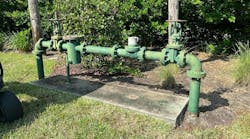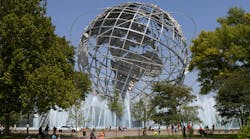Background
The predominant MSW disposal option in use today is the sanitary landfill. Landfills must meet the requirements of the Resource Conservation and Recovery Act (RCRA) Subtitle D, the Clean Water Act, the Clean Air Act, and numerous other federal, state, and local regulations. The intent and guiding principle of these regulations is to keep wastes “dry,” thus minimizing production of leachate and LFG, two of the major byproducts of waste degradation.
The underlying assumption is that a 30-year postclosure period is the minimum time necessary to effectively manage the very long-term environmental liabilities of the organic components, salts, and heavy metals contained within conventional dry Subtitle D landfills. The containment provided by these landfills offers environmental protection initially; however, at some point beyond the 30-year period there might be partial failure(s) of the containment lining system (underlying and overlying the waste). The primary environmental issue associated with partial containment system failure and moisture infiltration is the potential associated increase in gas and leachate production and the resulting impact of uncontrolled leachate and/or LFG releases on the environment. The nature and magnitude of the releases exiting the landfill and their resulting impacts are directly related to the amounts of organic waste not yet decomposed.
Bioreactor Landfill Differences
A bioreactor landfill is a sanitary landfill that uses enhanced microbiological processes to transform and stabilize the readily and moderately decomposable organic waste constituents within five to 10 years of bioreactor-process implementation. Stabilization means that the environmental-performance measurement parameters (LFG-composition, LFG-generation rate, and leachate-constituent concentrations) should remain at steady levels and should not increase in the event of any partial containment system failures beyond five to 10 years of bioreactor-process implementation.
The bioreactor landfill requires specific management activities and operational modifications to enhance microbial decomposition processes. The single most important and cost-effective method is liquid addition and management. Other strategies, including waste shredding, pH adjustment, nutrient addition, waste predisposal and postdisposal conditioning, and temperature management may also optimize the bioreactor process. Successful implementation also requires the development and implementation of focused operational and development plans.
In effect, the bioreactor landfill is merely an extension of the accepted Subtitle D leachate-recirculation landfill option. However, the bioreactor process requires significant liquid addition to reach and maintain optimal conditions. Leachate alone is usually not available in sufficient quantity to sustain the bioreactor process. Water or other nontoxic or nonhazardous liquids and semiliquids are suitable amendments to supplement leachate (depending on climatic conditions and regulatory approval). Other process amendment strategies may also be included, subject to regulatory approval. Although Subtitle D does permit recirculation of leachate and condensate from a specific landfill, many states have not yet endorsed the leachate recirculation option, let alone permitted the addition of water or other liquid amendments needed to facilitate the bioreactor activity.
Shortly following the closure of a bioreactor landfill, the LFG-generation rate will usually be at its highest. It will then quickly decline over the next five to 10 years to a stable, relatively low, declining rate. Similarly, shortly after landfill closure, many leachate-contaminant concentrations will change from highly polluted levels to much lower levels normally characteristic of extended stabilization. The leachate quantity at closure will be a finite amount, amenable to onsite treatment with limited need for offsite transfer, treatment, and disposal. In the event of postclosure partial-containment system failure, the quality of the leachate generated from infiltration into a bioreactor landfill will be much better than other drier Subtitle D landfills.
Evidence suggests that bioreactor landfills can meet Subtitle D requirements. A 1997 SWANA survey of 130 US bioreactor landfills indicates that most environmental and other relevant concerns have been resolved; information on leachate-recirculating landfills in existence worldwide is similarly positive.
Existing Regulations, Policy, and Activities
Present regulations generally encourage landfills to remain relatively dry. In most cases, the final moisture content remains close to that of the entering waste.
The federal code most pertinent to liquid addition is 40 CFR 258.28, which only allows reintroduction of leachate and condensate into Subtitle D lined landfills, described in 40 CFR 258.40(a)(2). Subtitle D does not expressly bar amendments and is in fact silent on the issue. Some states interpret 40 CFR 258.28 to mean that liquid addition, other than leachate and condensate, is not allowed into landfills. Despite this oft-taken position, federal code may be interpreted to prohibit only the addition of bulk liquid wastes, and not amendments, to landfills. Thus, water and other amendment additions to landfills appear permissible within regulations. For example, USEPA Region 10 approved an amendment to Washington State’s solid waste regulation that specifically allowed water addition in a controlled manner to a specific composite-lined Subtitle D landfill.
The bioreactor and leachate recirculating landfills differ from the dry Subtitle D landfills in that they each receive managed liquid additions to augment waste stabilization. The bioreactor landfill differs from the leachate-recirculating landfill in that it can obtain rapid and complete stabilization by use of water and other amendments. For the bioreactor landfill, water is clearly not a waste but an amendment. Other potential bioreactor additions, such as sludge and nutrients, could also be categorized as amendments. Federal code is open to necessary amendments providing that other statutory constraints are met, e.g., leachate head limits on the base liner and inclusions of a single composite liner.
Favorable federal policy toward the bioreactor landfill has begun to develop. In the federal Climate Change Action Plan of 1993, action item 37 contains, among others, the following relevant recommendations:
- Creation of a joint state/federal coordination program to facilitate siting/permitting of enhanced recovery (i.e., bioreactor) landfills, and
- Modification of environmental performance standards and regulatory requirements to remove unnecessary barriers to bioreactor landfills.
In addition to the support apparent in these policy statements, federal support seems implicit in the long-standing USEPA sponsorship of bioreactor experimental work. One representative compendium of work can be found in the EPA seminar publication Landfill Bioreactor Design and Operation, from the EPA symposium in Wilmington, DE, in March 1995. A large body of other work has been sponsored and published under EPA auspices over the past three decades.
With respect to states, a 1997 SWANA data-collection effort included a survey of state regulatory agencies to determine their position on leachate recirculation and landfills as bioreactors (Gou and Guzzone, 1997). Of 50 distributed surveys, 37 were returned.
The results indicate that approximately 130 MSW landfills are currently employing leachate recirculation. More than half (21) of the respondents cited specific state regulations on leachate recirculation. For the most part, the state requirements closely follow those stipulated under RCRA Subtitle D; i.e., a composite liner system and a leachate collection system to maintain leachate head levels below 1 ft.
Six states supplement their regulations with additional specific requirements, including gas collection, runoff controls, leak detection systems, and double liner systems (e.g., Delaware and New York). In other states, survey responses list no specific requirements, save a requirement to obtain department and state approval. For example, Ohio and Wyoming allow leachate recirculation; however, there are no specific state rules pertaining to the practice. Finally, three states do not permit recirculation at all. In these cases, either leachate production is not a primary concern (dry climate) or most of the state’s landfills are unlined or the state environmental agency simply does not find the practice researched and studied adequately for implementation.At the time the survey was administered (mid-1997), 14 states indicated one of three actions: they accept bioreactor landfills, approval was pending, or they would consider a proposal. States favoring, considering, or accepting bioreactor landfills included Alabama, Alaska, Arkansas, California, Colorado, Delaware, Florida, Iowa (one project pending), Michigan, Mississippi, Montana, New Jersey, New York, and Washington.
Arizona, Illinois, Kansas, Kentucky, Maryland, Massachusetts, Nebraska, New Hampshire, Ohio, and Pennsylvania indicated that they would not approve a bioreactor landfill. Others gave no answer or indicated that they were in the process of evaluating the technology. A primary reason cited by those not approving of bioreactor landfills was that most landfills were unlined. Those that did permit bioreactor landfills usually classified the practice under recirculation rather than as a separate category. In many of the states lacking specific bioreactor regulations, the practice had never even been requested. However, the topic had been considered internally through permit modifications or alterations.
Examples of Bioreactor Landfill Activities
California: For three years, Yolo County has been operating a bioreactor demonstration cell that contains 9,000 tons of refuse. Yolo County is negotiating with concerned state regulatory agencies to permit and then operate the next 15-ac. landfill cell of the Yolo County Central Landfill as a bioreactor.
Delaware: The Delaware Solid Waste Authority has operated the major landfill (largest in the state) at Sandtown as a bioreactor for more than 10 years.
Florida: The state recently allocated more than $3.2 million to establish a demonstration bioreactor landfill.
Georgia: Two aerobic bioreactor landfill projects are operational: one at the Live Oak Landfill in Atlanta, the other at the Baker Road Landfill in Columbia County.
Iowa: The Bluestem Solid Waste Authority has received a $500,000 state grant for its bioreactor project at the Bluestem No. 2 Landfill near Marion. Waste placement commenced in December 1998, and the demonstration project should receive final cover in June 1999.
New York: An anaerobic bioreactor operation is being carried out at the Mill Seat Landfill; a pretreatment aerobic bioreactor activity is operational at Elmira.
South Carolina: The State Research and Development and Demonstration Program is sponsoring an aerobic activity at the Aiken County Landfill.
Washington State: Washington Administrative Code 173-351-200(9) specifically permits bioreactor landfills. The pertinent section on operating criteria on liquid restrictions states: “Bulk or noncontainerized liquid waste may not be placed in MSWLF units unless: (ii) the waste is leachate or gas condensate derived from the MSWLF unit or water added in a controlled fashion and necessary for enhancing decomposition of solid waste, as approved during the permitting process of WAC 173-351-700, whether it is a new or existing MSLF or lateral expansion.”
Potential Benefits of the Bioreactor Landfill
Numerous benefits can be derived from the bioreactor landfill. These are situation-dependent and can affect different parties or stakeholders in different ways. They can accrue in the form of environmental, regulatory, monetary, and social benefits. Some of the key benefits include:
Rapid Organic Waste Conversion/Stabilization
- Rapid settlement: Volume reduced and stabilized within five to 10 years of bioreactor-process implementation.
- Increased gas unit yield, total yield, and flow rate: Almost all of the rapid and moderately decomposable organic constituents will be degraded within five to 10 years of closure.
- Improved leachate quality: Stabilizes within three to 10 years after closure. o Early land use possible following closure.
Maximizing of LFG Capture for Energy Recovery Projects
- Significant increase in total gas available for energy use, which provides entrepreneurial opportunities. o Potential increase in total LFG extraction efficiency (enabled over a shorter generation period).
- Additional greenhouse gas reduction from lessened emissions.
- Increase in fossil fuel offsets from increased gas-energy sales.
- Assistance in defraying LFG nonfunded environmental costs.
- Significant economy-of-scale advantage from high generation rate over a relatively short time.
Increased Landfill Capacity Reuse From Rapid Settlement During Operational Time Period
- Increase in the amount of waste that can be placed into the permitted landfill airspace (effective density increase).
- Extension of landfill life through additional waste placement.
- Deferred capital and financing costs needed to locate, permit, and construct a replacement landfill results in capital and interest savings.
- Significant increase in realized waste-disposal revenues.
Improved Leachate Treatment and Storage
- Low-cost partial or complete treatment; significant biological and chemical transformation of both organic and inorganic constituents, although mostly relevant to the organic constituents.
- Reintroduction of all leachate over most of the operational and postclosure care period significantly reduces leachate disposal costs.
- Absorption of leachate within landfill available up to field capacity.
Reduction in Postclosure Care, Maintenance, and Risk
- Rapid waste stabilization (within five to 10 years) minimizes environmental risk and liability as a result of settlement, leachate, and gas.
- Landfill operation and maintenance activities are considerably reduced.
- Landfill monitoring activities can be reduced.
- Reduction of financial package requirement.
- In the event of partial liner failure, there should be no risk of increased gas generation, worsening leachate quality, or increased settlement rate or magnitude.
Another major benefit of bioreactors could come from greenhouse gas abatement. Generally bioreactors can rapidly complete methane generation while attaining maximum yield. This can be combined with the nearly complete capture of generated gas using the bioreactor landfill in combination with an LFG energy project (Augenstein et al., 1997). With this approach, the high generation level and gas-capture efficiency maximizes landfill greenhouse-gas offset potential.
Additional goals and benefits may also accrue, including the transformation of certain resistant organics (dehalogenation, etc.) and sequestration of certain inorganics (precipitation, etc.) and the pollutant removal processes of filtration, capture, sorption, and so on that are promoted by leachate recirculation (Pohland, 1995).
Bioreactor Landfill Issues
Design
For the most part, state and federal regulations (primarily RCRA Subtitle D) dictate the design of the modern landfill. Required design components include the liner, leachate collection facilities, gas collection and management facilities, and final cap. These same components must be adapted during the operational period of the bioreactor landfill to manage leachate, including liquid introduction, and to handle enhanced gas generation. The following issues must be addressed to produce a successful project that satisfies regulatory concerns.
Cell Size. For economic and regulatory reasons, an emerging trend in traditional landfill design is to build deep cells (or phases) that are completed within two to five years. This trend bodes well for bioreactor landfill evolution. Phased cell construction can more easily take advantage of emerging technological developments, rather than committing long term to a design that might prove to be inefficient. Once closed, methanogenic conditions within the cell (phase) are optimized and gas generation and extraction are facilitated. However, extremely deep landfills might be so dense in the lower portions that refuse permeability will inhibit leachate flow. In these instances, it might be necessary to limit addition and/or recirculation to the upper levels or develop adequate internal drainage management capability.
Maximum Allowable Leachate Head on the Bottom Liner. Federal regulations prescribe a 1-ft. maximum allowable leachate head on the bottom liner. This criterion can be readily achieved through appropriate design and bottom-liner slopes, drainage-layer flow distances, and hydraulic conductivity of the leachate drainage layer. The design can be aided by the use of mathematical models such as HELP3 developed by the Army Corps of Engineers (Schroeder et al., 1994). Since leachate-head predictions are based on mathematical models, regulatory agencies may require monitoring to verify performance.
Liquid Management. An estimate of the design flow rates and liquid storage and supplementation capacity must be developed for the liquid management system. Sufficient storage will be required to ensure that peak leachate-generation events can be accommodated. Sufficient liquid supply (i.e., leachate, water, wastewater, or sludge) must be ensured to support project goals. The volume of liquid needed to reach waste field capacity can be based on prior field studies, model predictions, or landfill-specific measurement. Expressed as a volume per mass of solid waste, the range of liquid addition to reach field capacity is 25,000-50,000 gal. per 1,000 tons of solid waste (Reinhardt and Ham, 1974).
There are various methods of adding liquid. Methods that directly apply the leachate and water to the solid waste can target moisture supplementation levels (desired gallons per ton or cubic yard) during active landfilling. One option is to apply the liquid at the working face as refuse is placed into the landfill. In this case, however, operators must be prepared to deal with increasing gas generation shortly thereafter.
Another option is to add moisture after waste placement, which controls the onset of rapid gas generation. Applying leachate and water to solid waste already in place can be accomplished by using surface irrigation systems, infiltration ponds, injection wells, or trenches. Selection considerations include climate, malodors, worker exposure, environmental impacts, evaporative loss, reliability, uniformity, and aesthetics. Buried trenches or vertical wells offer advantages of minimum exposure pathways, good all-weather performance, and favorable aesthetics. However, they may be adversely impacted by differential settlement. Guidance on liquid addition, alternative design, and performance can be found in Reinhart and Townsend (1997).
Solid Waste Density Considerations. Adding liquid to solid waste will increase its density, which can be of critical importance in the design of load-bearing structural members in the landfill. Most notably, the leachate and LFG collection system must be designed to accommodate the increased load, which may be as much as 30% heavier because of expected moisture uptake and settlement. The design process for determination of the buried leachate pipe load-bearing capacity is described in Harrison and Watkins (1996).
Landfill Gas Control System. A bioreactor landfill will generate more LFG in a much shorter time than a drier landfill will. To efficiently control gas and avoid odor problems, the bioreactor LFG extraction system may require installation of larger pipes, blowers, and related equipment early in its operational life. Horizontal trenches, vertical wells, near-surface collectors, or hybrid systems may be used for gas extraction. Greater gas flows are readily accommodated by increased pipe diameter as capacity increases as the square of pipe diameter. Liquid addition systems should be separate from gas extraction systems to avoid flow impedance. The porous leachate removal system underlying the refuse should be considered for integration with the gas extraction system.
Enhanced gas production can negatively impact sideslopes and cover if an efficient collection system is not installed during active landfill phases. Uplift pressure on geomembrane covers during installation can cause ballooning of the membrane and may lead to some local instability and soil loss. Temporary venting or aggressive extraction of gas during cover installation might facilitate cover placement. Once the final cover is in place, venting should be adequate to resist the uplift force created by LFG pressure buildup. The designer should consider the pressure buildup condition on slope stability when the collection system is shut down for any significant amount of time.
Landfill Stability. Addition of liquid into the refuse to increase biological activity will increase the total weight of the refuse mass and may cause an increase in internal pore pressure. This stability issue can be readily assessed and resolved with standard geotechnical analyses (Maier, 1998). Seismic effects should also be considered during geotechnical analysis, when appropriate.
Settlement. A bioreactor landfill will experience more rapid, total, and complete settlement than will a drier landfill. Accelerated settlement results from both an increased rate of solid waste decomposition and increased compression through higher specific weights. Settlement during the landfilling operations will impact the performance of the final surface grade, surface drainage, roads, gas-collection piping system, and leachate-distribution piping system. Because of the significant increase in settlement magnitude and rate, it could be very beneficial to overfill the refuse above design grade before placement of the final cover. Alternatively, a significant benefit may accrue if final cover and final site-improvement installations are postponed and the rapid settlement is used to recapture airspace. Settlement impacts can be readily accommodated by the project design. Since settlement will be largely complete soon after landfill closure, long-term maintenance costs and the potential for fugitive emissions will be avoided.
Operations
The bioreactor landfill is a waste treatment system. During landfill operations, it requires closer attention to system performance than the drier landfill does. Successful operation of a bioreactor landfill depends on control and monitoring of biological, chemical, and hydrologic processes occurring within the landfill. Operational and maintenance programs addressing settlement, LFG, and leachate may be reduced to a minimal level once the landfill is closed and the refuse is largely stabilized.
Solid Waste Pretreatment or Segregation. Bioreactor operations are most efficient and effective where the refuse has high organic content and large exposed specific surface area. For this reason, bioreactor operations should be concentrated on waste segregated to maximize its organic content and shredded, flailed, or otherwise manipulated to increase its exposed surface area. Waste segregation could include separation of construction and demolition wastes from MSW. Limited shredding can be obtained by spreading refuse in thin lifts and using landfill equipment to break open plastic bags and break down containers. Mechanical shredding can be efficient and effective in reducing particle size and opening bags; however, it is an intensive, high-maintenance, and high-cost activity that might not be cost-effective. Moreover, shredded wastes may become exceedingly dense after placement, thereby limiting moisture penetration.
Leachate Seeps.





